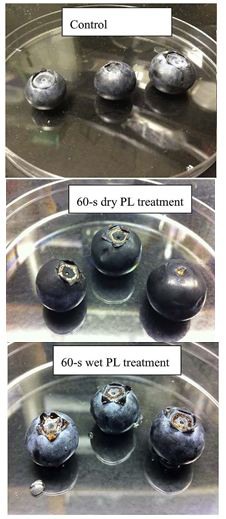 In recent years, the application of pulsed light (PL) technology for fresh produce decontamination has been limited because it causes the produce heating with serious consequences on organoleptic properties and impacts adversely the surface colour (= shadowing effect).
In recent years, the application of pulsed light (PL) technology for fresh produce decontamination has been limited because it causes the produce heating with serious consequences on organoleptic properties and impacts adversely the surface colour (= shadowing effect).Scientists at University of Delaware (USA) have evaluated the efficacy of PL technology in inactivating Escherichia coli O157:H7 and Salmonella growth on blueberries. Moreover, they try to set up this novel technology to minimize the adverse effects of PL, such as heating and shadowing, on the physical and sensorial properties of blueberries.
Scientists have compared two PL treatments:
- Dry Pulsed Light (DPL): inoculated blueberries were directly PL illuminated for 5, 15, 30, and 60 s;
- Wet Pulsed Light (WPL): inoculated blueberries were immersed in agitated tap water during the PL treatment for 5, 15, 30, and 60 s.
On the base of these results, the scientists have compared the antibacterial efficacy of WPL with 60-s chlorine washing (10 ppm chlorine). Chlorinated water was generally used by the food industry to wash blueberries intended for further processing such as frozen storage.
From the comparison, it resulted that WPL was more effective than chlorinated water in inactivating the investigated pathogens. After 60 s of WPL, the population of E. coli inoculated on calyx and skin was respectively reduced by 3.0 and >5.8 CFU/g, while the population of Salmonella inoculated on calyx and skin was respectively reduced by 3.6 and >5.9 CFU/g.
Source: Huang Y. e Chen H., "A novel water-assisted pulsed light processing for decontamination of blueberries", Food Microbiology, 2014, Vol. 40, pagg. 1-8. http://www.ncbi.nlm.nih.gov/pubmed/24549191








